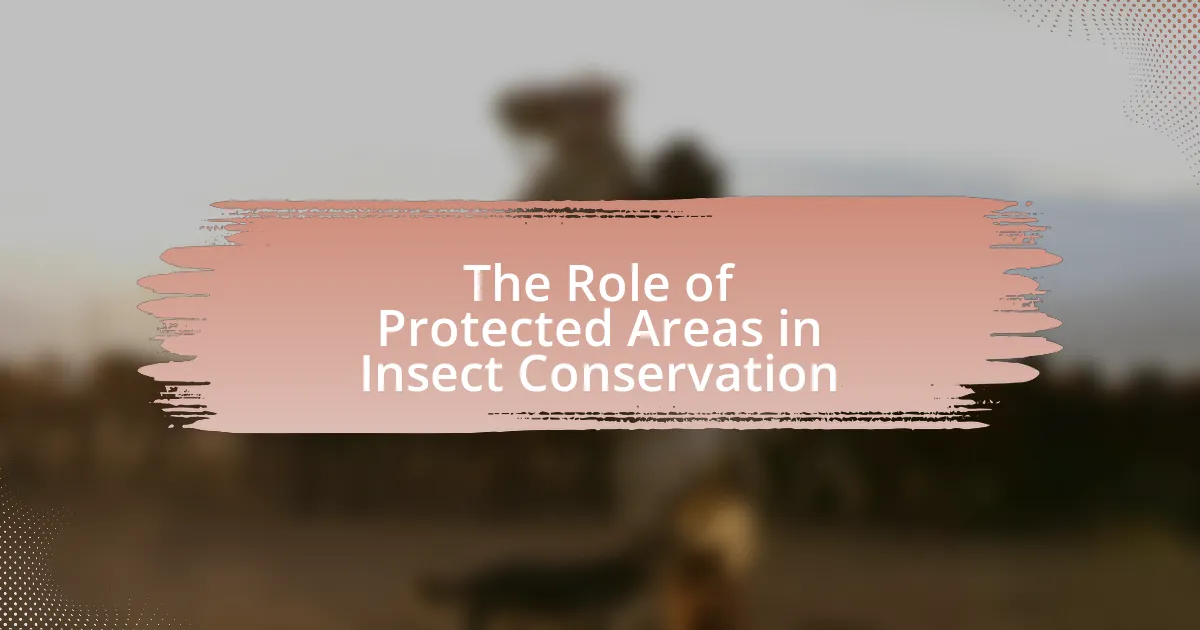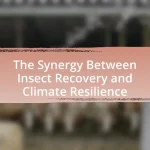Protected areas are essential for insect conservation, providing vital habitats that support biodiversity and ecosystem services. These designated regions help preserve various insect species by maintaining their natural environments, which are crucial for survival and reproduction. The article explores the importance of protected areas in enhancing insect populations, the types of insects that benefit, and the specific habitats critical for their conservation. It also addresses challenges faced by these areas, such as climate change and habitat fragmentation, while highlighting effective management practices and community involvement that can improve conservation outcomes. Additionally, the article discusses the role of technology and innovative strategies in monitoring and enhancing insect populations within protected areas.
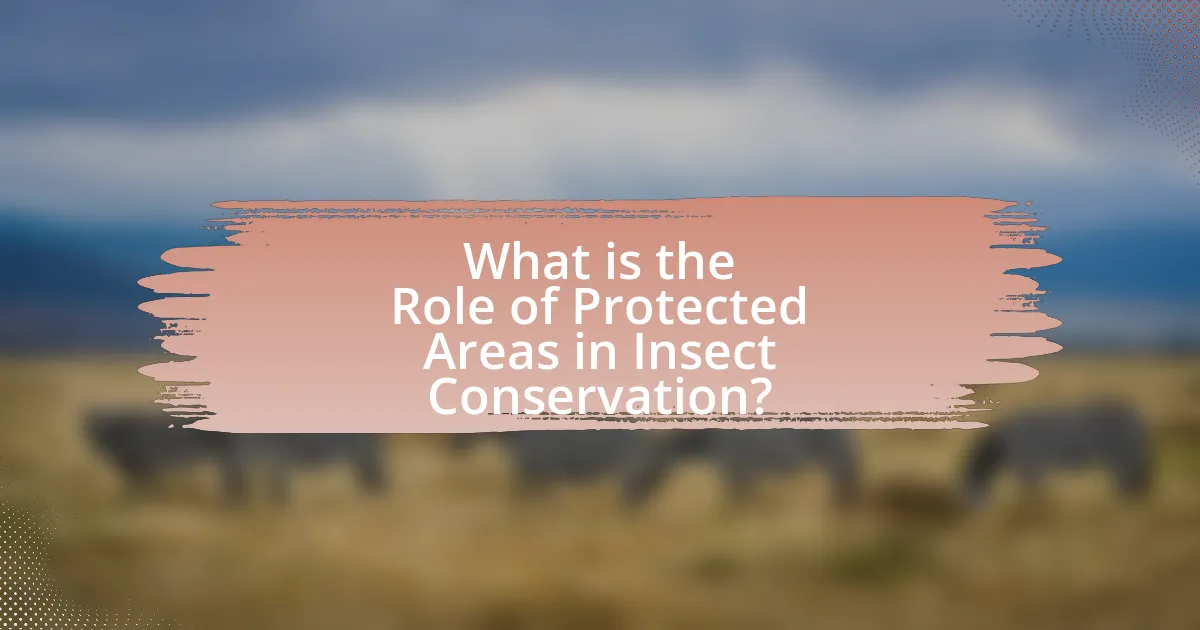
What is the Role of Protected Areas in Insect Conservation?
Protected areas play a crucial role in insect conservation by providing habitats that protect biodiversity and facilitate ecosystem services. These designated regions help preserve various insect species by maintaining their natural environments, which are essential for their survival and reproduction. For instance, studies have shown that protected areas can support higher insect diversity compared to non-protected regions, as they often contain a greater variety of habitats and fewer human disturbances. Additionally, protected areas contribute to the conservation of pollinators, which are vital for food production and ecosystem health, by ensuring the availability of flowering plants and nesting sites.
Why are protected areas important for insect populations?
Protected areas are crucial for insect populations because they provide essential habitats that support biodiversity and ecosystem functions. These designated regions help preserve various insect species by offering refuge from habitat destruction, pollution, and climate change. For instance, studies have shown that protected areas can maintain higher insect diversity compared to unprotected landscapes, with some research indicating that these areas can support up to 50% more species. Additionally, protected areas facilitate the preservation of critical resources such as food and breeding sites, which are vital for the survival of many insect species.
What types of insects benefit from protected areas?
Protected areas benefit various types of insects, particularly those that are endangered, endemic, or specialized in their habitat requirements. For instance, butterflies, bees, and beetles often thrive in these environments due to the preservation of their natural habitats and food sources. Research indicates that protected areas can enhance biodiversity, providing critical ecosystems for pollinators like honeybees and native bees, which are essential for plant reproduction and agricultural productivity. Additionally, studies show that specific habitats within protected areas, such as wetlands and forests, support unique insect species that rely on these ecosystems for survival, thereby contributing to overall ecological balance.
How do protected areas contribute to insect biodiversity?
Protected areas contribute to insect biodiversity by providing habitats that support diverse ecosystems. These designated regions often preserve native flora and fauna, which are essential for sustaining insect populations. For instance, studies have shown that protected areas can harbor up to 50% more insect species compared to non-protected landscapes, as they offer refuge from habitat destruction and pesticide use. Additionally, the maintenance of ecological processes within these areas, such as pollination and nutrient cycling, further enhances insect diversity.
How do protected areas help in the preservation of insect habitats?
Protected areas help in the preservation of insect habitats by providing safe environments that reduce habitat destruction and fragmentation. These designated regions often restrict human activities such as agriculture, urban development, and logging, which are primary threats to insect habitats. For instance, a study published in the journal “Biological Conservation” found that protected areas can maintain higher biodiversity levels, including insect populations, compared to unprotected landscapes. This is due to the preservation of native vegetation and ecosystems that support various insect species, thereby enhancing their survival and reproduction rates.
What specific habitats are crucial for insect conservation?
Specific habitats crucial for insect conservation include wetlands, forests, grasslands, and urban green spaces. Wetlands provide essential breeding and feeding grounds for many insect species, particularly aquatic insects and pollinators. Forests offer diverse microhabitats and food sources, supporting a wide range of insects, including beetles and butterflies. Grasslands serve as critical habitats for pollinators and other insects, contributing to ecosystem services such as pollination and soil health. Urban green spaces, such as parks and gardens, can enhance biodiversity by providing refuge and resources for insects in urban environments. These habitats collectively support insect populations and contribute to overall ecosystem health.
How do protected areas mitigate habitat loss for insects?
Protected areas mitigate habitat loss for insects by preserving critical ecosystems and maintaining biodiversity. These designated regions provide safe havens where insect populations can thrive without the pressures of urbanization, agriculture, and industrial development. Research indicates that protected areas can support higher insect diversity and abundance compared to unprotected landscapes, as they often contain native vegetation and complex habitats essential for various life stages of insects. For example, a study published in the journal “Biological Conservation” found that insect populations in protected areas were significantly more stable and resilient to environmental changes, demonstrating the effectiveness of these areas in conserving insect habitats.
What challenges do protected areas face in insect conservation?
Protected areas face significant challenges in insect conservation, primarily due to habitat fragmentation, climate change, and invasive species. Habitat fragmentation disrupts the connectivity between ecosystems, making it difficult for insect populations to thrive and migrate, which is essential for genetic diversity and resilience. Climate change alters temperature and precipitation patterns, affecting the life cycles and distribution of many insect species, leading to mismatches in ecological interactions. Additionally, invasive species can outcompete native insects for resources, further threatening their survival. These challenges highlight the need for adaptive management strategies within protected areas to effectively conserve insect biodiversity.
How does climate change impact protected areas and insect populations?
Climate change negatively impacts protected areas and insect populations by altering habitats and disrupting ecological balance. Rising temperatures and changing precipitation patterns can lead to habitat loss, making it difficult for many insect species to survive. For instance, studies have shown that climate change can shift the distribution of insect populations, with some species migrating to higher altitudes or latitudes in search of suitable conditions, while others face extinction due to their inability to adapt. Additionally, protected areas may become less effective as climate refuges if they do not encompass a range of habitats that can support diverse insect communities under changing climate conditions.
What human activities threaten the effectiveness of protected areas?
Human activities that threaten the effectiveness of protected areas include habitat destruction, pollution, invasive species introduction, and climate change. Habitat destruction, often driven by agriculture, urban development, and logging, reduces the size and quality of ecosystems within protected areas, making it difficult for species to thrive. Pollution from agricultural runoff and industrial waste contaminates soil and water, adversely affecting the health of both flora and fauna. The introduction of invasive species disrupts local ecosystems by outcompeting native species for resources, leading to declines in biodiversity. Climate change alters temperature and precipitation patterns, impacting species distributions and ecosystem dynamics. These activities collectively undermine the conservation goals of protected areas, as evidenced by studies showing significant declines in insect populations and biodiversity in regions facing these threats.
How can the effectiveness of protected areas in insect conservation be measured?
The effectiveness of protected areas in insect conservation can be measured through biodiversity assessments, population monitoring, and habitat quality evaluations. Biodiversity assessments involve cataloging insect species within protected areas to determine species richness and abundance compared to unprotected areas. For instance, studies have shown that protected areas often harbor higher insect diversity, indicating their role in conservation. Population monitoring tracks specific insect populations over time, providing data on trends and the impact of conservation efforts. Additionally, habitat quality evaluations assess the ecological integrity of the environment, including factors like vegetation structure and availability of resources, which directly influence insect populations. Research has demonstrated that well-managed protected areas can significantly enhance insect conservation outcomes, as evidenced by increased populations of pollinators and other beneficial insects in these regions.
What indicators are used to assess insect populations in protected areas?
Indicators used to assess insect populations in protected areas include species richness, abundance, and diversity indices. Species richness measures the number of different species present, while abundance quantifies the total number of individuals within those species. Diversity indices, such as the Shannon-Wiener index, provide insights into the distribution of species and their relative abundance. These indicators are essential for evaluating ecosystem health and the effectiveness of conservation efforts, as demonstrated in studies that correlate higher insect diversity with improved ecosystem services and resilience.
How do researchers monitor the health of insect communities in these areas?
Researchers monitor the health of insect communities in protected areas through methods such as biodiversity assessments, population surveys, and habitat evaluations. These techniques involve collecting data on insect species richness, abundance, and distribution, which helps in understanding community dynamics and ecosystem health. For instance, studies often utilize standardized sampling protocols, such as pitfall traps and sweep nets, to quantify insect populations and identify species present. Additionally, researchers may employ remote sensing and environmental DNA analysis to assess habitat quality and detect changes in insect communities over time. These methods provide concrete evidence of the ecological status of insect populations, enabling effective conservation strategies in protected areas.
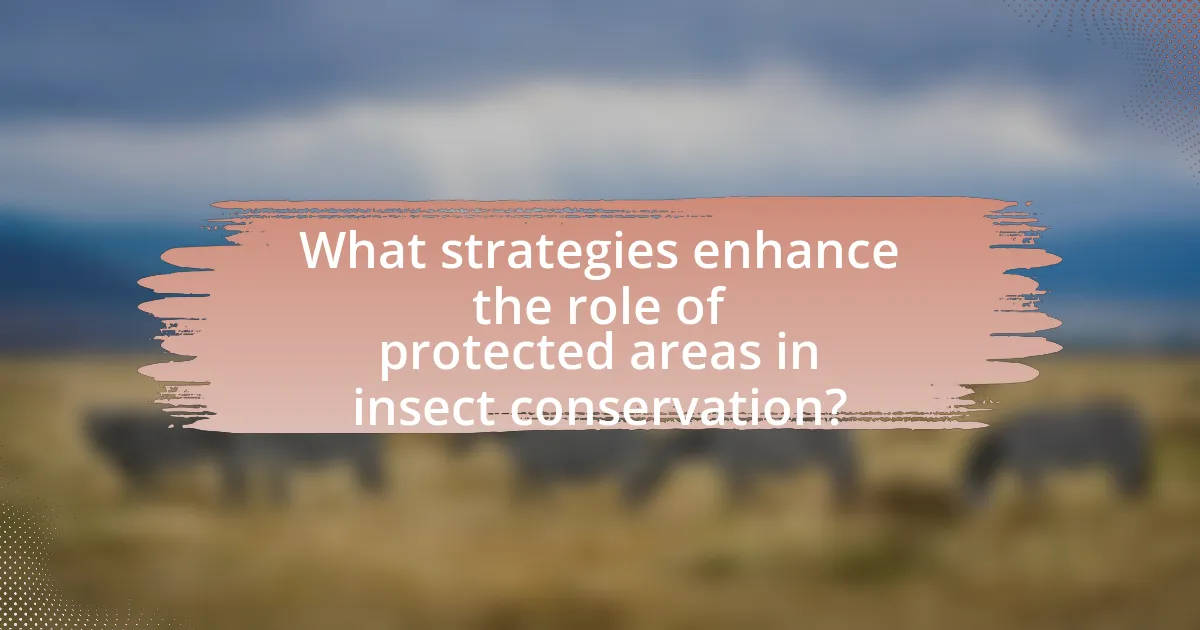
What strategies enhance the role of protected areas in insect conservation?
Strategies that enhance the role of protected areas in insect conservation include habitat restoration, management of invasive species, and the establishment of ecological corridors. Habitat restoration improves the quality and availability of resources for insects, which is crucial for their survival and reproduction. Managing invasive species prevents them from outcompeting native insects, thereby maintaining biodiversity. Additionally, creating ecological corridors connects fragmented habitats, allowing for gene flow and movement of insect populations, which is essential for their resilience. Research indicates that protected areas with these strategies can significantly increase insect diversity and abundance, as demonstrated in studies conducted in various ecosystems worldwide.
How can management practices improve insect conservation in protected areas?
Management practices can improve insect conservation in protected areas by implementing habitat restoration, controlling invasive species, and enhancing connectivity between habitats. Habitat restoration, such as reforestation and wetland rehabilitation, directly increases the availability of resources for insects, thereby supporting their populations. Controlling invasive species prevents competition and predation that can threaten native insect species, as evidenced by studies showing that invasive plants can reduce native insect diversity. Enhancing connectivity through the establishment of ecological corridors allows for the movement of insects between fragmented habitats, which is crucial for maintaining genetic diversity and resilience. These practices are supported by research indicating that well-managed protected areas can significantly boost insect biodiversity and ecosystem health.
What role does habitat restoration play in enhancing insect populations?
Habitat restoration plays a crucial role in enhancing insect populations by re-establishing the ecological conditions necessary for their survival and reproduction. Restored habitats provide essential resources such as food, shelter, and breeding sites, which are often lost due to urbanization, agriculture, and other human activities. For instance, studies have shown that restored wetlands can support up to 50% more insect species compared to degraded areas, highlighting the importance of habitat quality in biodiversity. Furthermore, habitat restoration efforts, such as reforestation and the creation of pollinator gardens, have been linked to increased abundance and diversity of pollinators, which are vital for ecosystem functioning and agricultural productivity.
How can community involvement support insect conservation efforts?
Community involvement can significantly support insect conservation efforts by fostering local stewardship and enhancing habitat protection. Engaging communities in conservation initiatives leads to increased awareness of the ecological importance of insects, which can result in local advocacy for protective measures. For instance, studies have shown that community-led conservation programs can improve biodiversity outcomes, as seen in the case of the Monarch Butterfly in North America, where local groups have successfully implemented habitat restoration projects. Furthermore, when communities participate in monitoring and research activities, they contribute valuable data that can inform conservation strategies, thereby strengthening the overall effectiveness of insect conservation efforts.
What policies support the establishment and maintenance of protected areas for insects?
Policies that support the establishment and maintenance of protected areas for insects include the Convention on Biological Diversity, national biodiversity strategies, and specific legislation aimed at habitat protection. The Convention on Biological Diversity, adopted in 1992, emphasizes the importance of conserving biological diversity, which directly impacts insect populations by promoting the creation of protected areas. National biodiversity strategies often incorporate specific targets for insect conservation, ensuring that habitats critical for insect survival are preserved. Additionally, legislation such as the Endangered Species Act in the United States provides legal frameworks for protecting habitats that are essential for the survival of threatened insect species, thereby supporting the establishment and maintenance of protected areas.
How do international agreements influence local conservation efforts?
International agreements significantly influence local conservation efforts by establishing frameworks that promote biodiversity protection and sustainable practices. These agreements, such as the Convention on Biological Diversity, set binding targets for countries, encouraging local governments to implement conservation strategies aligned with international standards. For instance, countries that commit to these agreements often receive funding and technical support, which can enhance local conservation initiatives. Additionally, international agreements facilitate knowledge sharing and collaboration among nations, leading to improved conservation outcomes at the local level.
What funding mechanisms are available for insect conservation in protected areas?
Funding mechanisms available for insect conservation in protected areas include government grants, private donations, international conservation funds, and public-private partnerships. Government grants often come from environmental agencies that allocate budgets specifically for biodiversity and conservation projects, such as the U.S. Fish and Wildlife Service’s funding programs. Private donations can be sourced from individuals or organizations committed to conservation efforts, while international conservation funds, like those from the Global Environment Facility, provide financial support for projects aimed at preserving biodiversity in protected areas. Public-private partnerships leverage resources from both sectors to enhance conservation initiatives, ensuring sustainable funding for insect conservation efforts.
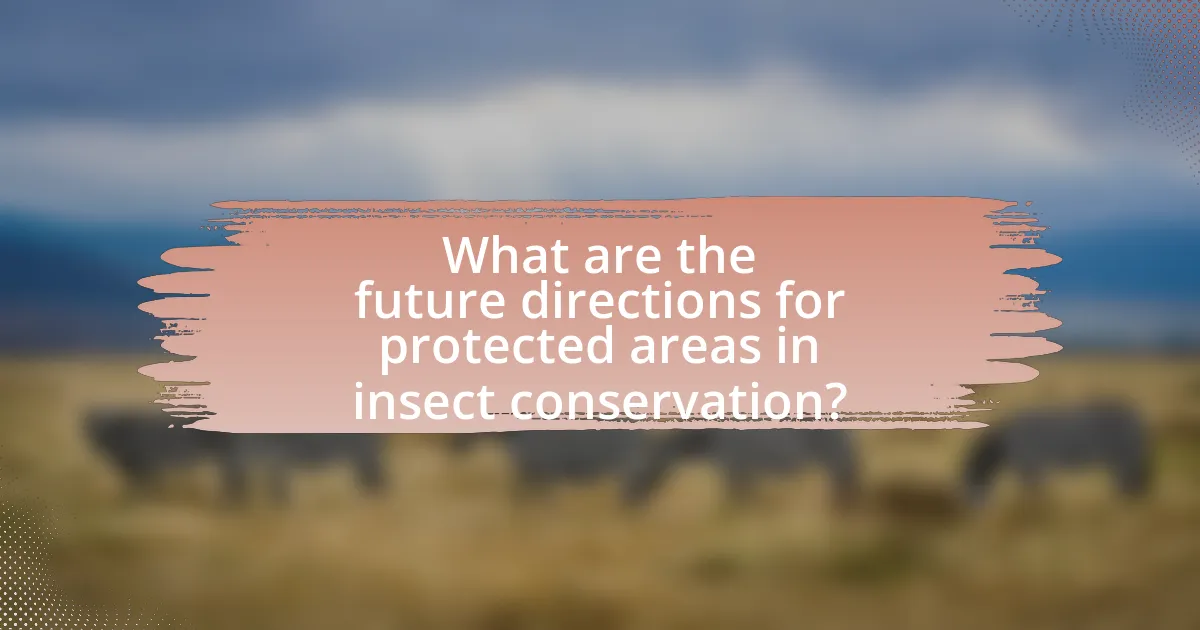
What are the future directions for protected areas in insect conservation?
Future directions for protected areas in insect conservation include enhancing habitat connectivity, implementing adaptive management strategies, and increasing stakeholder engagement. Habitat connectivity is crucial as fragmented landscapes hinder insect movement and gene flow, which can lead to population declines. Adaptive management strategies allow for the flexibility to respond to changing environmental conditions and threats, ensuring that conservation efforts remain effective. Furthermore, increasing stakeholder engagement, including local communities and policymakers, fosters collaborative approaches that can lead to more sustainable management practices. These directions are supported by studies indicating that integrated conservation strategies significantly improve biodiversity outcomes in protected areas.
How can technology aid in the conservation of insects within protected areas?
Technology can aid in the conservation of insects within protected areas by utilizing tools such as remote sensing, data analytics, and automated monitoring systems. Remote sensing technologies, like satellite imagery, allow for the assessment of habitat changes and the identification of critical areas for insect populations. Data analytics can process large datasets to track insect diversity and population trends, enabling targeted conservation efforts. Automated monitoring systems, including camera traps and acoustic sensors, facilitate real-time observation of insect behavior and interactions, providing valuable insights into ecosystem health. These technological advancements enhance conservation strategies by enabling more effective management and protection of insect species in their natural habitats.
What role do citizen science and data collection play in insect monitoring?
Citizen science and data collection are crucial for insect monitoring as they enhance the volume and diversity of data available for research. Citizen scientists contribute to large-scale data collection efforts, allowing for the tracking of insect populations and behaviors across various geographic regions. For instance, initiatives like the North American Butterfly Association’s Butterfly Count involve thousands of volunteers who gather data on butterfly species, providing valuable insights into population trends and habitat changes. This participatory approach not only increases the amount of data collected but also fosters public engagement and awareness about insect conservation, which is vital for effective management strategies in protected areas.
How can innovative conservation strategies be implemented in protected areas?
Innovative conservation strategies can be implemented in protected areas through the integration of technology, community engagement, and adaptive management practices. For instance, the use of remote sensing and geographic information systems (GIS) allows for real-time monitoring of biodiversity and habitat changes, enabling timely interventions. Community involvement in conservation efforts, such as citizen science programs, fosters local stewardship and enhances data collection on insect populations. Additionally, adaptive management practices, which involve continuous learning and adjustment of strategies based on outcomes, ensure that conservation efforts remain effective in the face of changing environmental conditions. These approaches have been shown to improve conservation outcomes, as evidenced by studies indicating that areas employing technology and community engagement report higher biodiversity levels and more resilient ecosystems.
What best practices can be adopted for effective insect conservation in protected areas?
Effective insect conservation in protected areas can be achieved through habitat preservation, restoration of native vegetation, and the implementation of integrated pest management strategies. Habitat preservation ensures that critical ecosystems remain intact, supporting diverse insect populations. Restoration of native vegetation enhances food sources and breeding sites for insects, which is vital for their survival. Integrated pest management strategies reduce the reliance on chemical pesticides, minimizing harm to non-target insect species. Research indicates that protected areas with diverse habitats support higher insect diversity, which is essential for ecosystem functioning and resilience.
How can stakeholders collaborate to enhance conservation outcomes?
Stakeholders can collaborate to enhance conservation outcomes by forming partnerships that leverage diverse expertise and resources. Collaborative efforts, such as joint management initiatives between government agencies, NGOs, and local communities, can lead to more effective conservation strategies. For instance, the establishment of protected areas often involves input from various stakeholders, ensuring that ecological, social, and economic factors are considered. Research indicates that collaborative governance models, which include stakeholder engagement, can improve biodiversity outcomes by 30% compared to traditional top-down approaches. This evidence underscores the importance of inclusive decision-making in achieving successful conservation results.
What are the key takeaways for improving insect conservation in protected areas?
Key takeaways for improving insect conservation in protected areas include enhancing habitat diversity, implementing effective management practices, and fostering community engagement. Habitat diversity supports a wider range of insect species by providing various niches and resources, as evidenced by studies showing that ecosystems with diverse plant life sustain more insect populations. Effective management practices, such as controlling invasive species and minimizing pesticide use, have been shown to improve insect health and biodiversity. Additionally, engaging local communities in conservation efforts leads to better stewardship and awareness, which is crucial for the long-term success of conservation initiatives.
